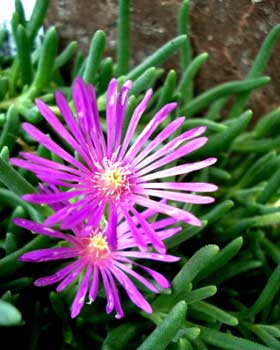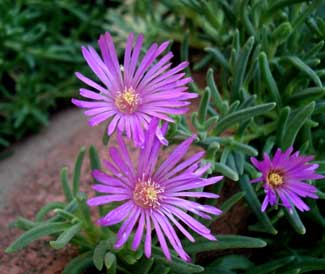
Mrs. de Leeuw's
Hardy Ice Plant
"Be like the flower
Turn your face to the sun."
-Kahlil Gibran
(1883-1931)
(1883-1931)
Planted in the fullest afternoon sun-side of a trough that surrounds a tall bottomless planter made out of an old concrete pipe, Delosperma deleeuwiae (de-low-SPER-ma de-LEW-ee-ay) seems to enjoy this spot, with long summer sun exposure & sharply draining soil in the trough.
It produces a strong dense mat of small green cylindrical succulent leaves humping up to as much as five inches, or as thin as two or three, & spilling over the trough edge. It's one of the hardiest of hardy ice plants for its foliage. It does well with occasional watering in sharply draining soil, but can suffer in soil that is too often wet.
 Like other ice plants, it is drought tolerant, a perfect flowering groundcover for the xeriscape garden. Groundcovers this short frequently don't really suppress weeds, but the rootstock is as dense as the foliage, so that very little ever has a chance of poking through (sometimes a dandylion establishes itself is all).
Like other ice plants, it is drought tolerant, a perfect flowering groundcover for the xeriscape garden. Groundcovers this short frequently don't really suppress weeds, but the rootstock is as dense as the foliage, so that very little ever has a chance of poking through (sometimes a dandylion establishes itself is all).It begins to bloom (for us, tepidly) somewhere between May & mid-July. Come August it blooms more impressively, aster-like magenta blooms with a mere dot of a yellow eye. It will reflower through September. It greatly resembles the more commonly encountered D. cooperi, not quite as metallic in its purple sheen, & its petals are slimmer.
Individual blooms don't last long, & in our garden have never been as numerous as for D. cooperi, which is much more floriferous. The main reason to add D. deleeuwiae to the array of succulents would be a gardener's fixation on having maximum varieties of ice plants. If a garden had only one ice plant, it should be the more common one, which never disappoints.
The rubbery foliage though evergreen may die back a bit during winter dormancy, reviving quickly in spring. Spread is potentially limitless, until it reaches an area too moist, or a spot too overshadowed by larger plants to continue that direction. It covers ground less quickly than does D. cooperi, however, making it easier to restrain without effort, but if one wanted the fastest widest coverage, D. cooperi again remains the choice.
First described in 1926 by South African plant explorer Mrs. de Leeuw, it entered into horticultural circles & everyday gardens through the efforts of Czech plant explorer Joseph Halda, who collected this ice plant at 12,000 feet in the mountains of Lesotho, South Africa, where it grew on dry sunny slopes.
Being from such a chilly height, it may be that this species will prove hardy to Zone 4, but to Zone 5 more certainly, & ideal for zones 7 through 9. It is perfect for our Puget Sound region, just so long as its soil drains well during our rainiest periods.